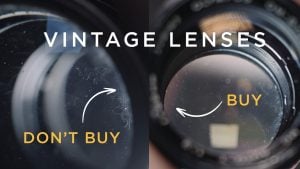

Congrats, you’ve found a vintage lens of your dreams! But wait a minute – you need to inspect it thoroughly first, who knows what it’s been through. This fantastic guide from Media Division will help you identify common defects and determine whether your new old lens is a treasure or trash.
What you’ll need
Light source
You’ll need a strong light source with an adjustable arm, and a desk lamp will do just fine. Hold the lens so the light shines through it from behind. This illuminates defects for easier detection. Play with the angle until you can clearly see the lens elements. You can even use a dark object or your finger to block some light, further highlighting tiny imperfections. Remember, zoom lenses require inspection at various zoom settings, as some defects might only be visible at specific focal lengths.
Your phone as a magnifying glass
A smartphone with a good close-up camera can be a valuable tool. Live view offers three advantages:
Magnification: Zoom in for a closer look at potential issues.
Shallow depth of field: The close focus creates a shallow depth of field, making it easier to pinpoint the location of defects on different lens surfaces.
Documentation: Capture photos or videos of defects for reference.
Common defects and their impact
There are some common defects in vintage lenses. The guys at Media Division give a clear and detailed overview of nine of them, along with examples, so you can easily recognize them.
Scratches: Sometimes there will be deep scratches, often caused by tools or improper cleaning. You can feel them with your finger or fingernail, and these might cause flares at high f-stops.
Cleaning marks: These are fine, circular scratches caused by cleaning particles. While they may not be noticeable by touch, severe cases can create a haze that affects image quality.
Balsam separation: The adhesive holding lens elements together can deteriorate over time, causing separation. This often starts at the edges due to moisture ingress but can also occur internally due to temperature changes.
Haze: This can be caused by internal contaminants like trapped moisture or fungus growth. While moisture-induced haze can be cleaned, fungus is more difficult and often requires professional removal. I mean, you can do it at home, but keep in mind that fungus is stubborn! The separation we mentioned above can also contribute to a hazy appearance.
Fungus: Easily identified by its web-like patterns, fungus thrives in high-humidity environments. The good news is that it can be treated, but the bad news is that prolonged growth can irreversibly damage the lens coating.
Chipping: Chips or cracks on the glass can occur from drops or excessive stress. While small, off-center chips might not affect the image, they can create flares.
Paint defects: Paint chipping inside the lens barrel can be a result of chemical reactions or mechanical damage. Internal chipping might indicate a chemical degradation issue, but for lens rehousing, only paint defects within element groups matter.
Radiation defects: Certain lens elements containing Thorium can develop a yellowing cast over time due to radiation exposure. This acts like a filter and reduces light transmission. Luckily, this effect is reversible with UV light exposure. And no, Thoriums is not harmful… At least not unless you ingest the lens.
Iris defects: Mechanical issues or contaminants can affect the iris function. This is only a concern if the iris won’t be replaced during lens rehousing, as cleaning it can potentially damage the mechanism.
Judging the severity
Okay, so you’ve found some defects on your lens, now what? Do you put it back on the shelf and move on? Or you take it home with you and give it a new life? It’s good to know that, even if the lens is not in perfect condition, not all defects are dealbreakers. Here’s how to assess their impact:
Correctability: Consider if the issue can be addressed through cleaning, UV treatment, or iris replacement.
Severity: How significant is the defect? A minor scratch has a lesser impact than a large chip.
Location: Defects near the center of the lens are generally more critical than those on the edges.
Personal preference: How much does image quality matter to you? Some photographers might tolerate minor flaws for a unique vintage look.
Lens rarity: If the lens is rare and has no alternatives, you might be more accepting of imperfections.
Severe coating damage and separation are generally the most problematic since they’re difficult and expensive to repair. Most rehousing services won’t even tackle these issues, so that’s something to keep in mind as well.
By following these guidelines, you can effectively inspect your vintage lens and determine if it meets your needs. With a little detective work, you can ensure your new treasure delivers beautiful, character-filled images for years to come.
[How to Judge a Vintage Lens – A crash course on how to identify and evaluate lens defects via ISO 1200]







